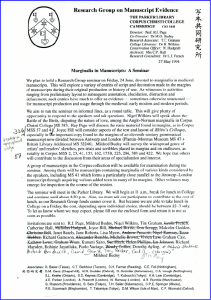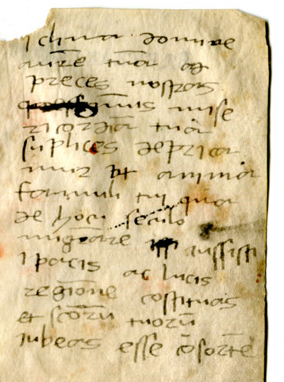2016 M-MLA Report
March 14, 2017 in Announcements, Conference Announcement, Manuscript Studies, Reports
Border States:
Marginalia in North American Manuscripts and Printed Books
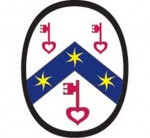 Two Panels
Two Panels
Sponsored by the Research Group on Manuscript Evidence
and Organized by Justin Hastings
(Department of English, Loyola University Chicago)
at the Convention of the Midwest Modern Language Association (M-MLA)
held on 10-13 November 2016 at St. Louis, Missouri
[Report for our Panels on Marginalia in Books for 2016 M-MLA]
The Research Group on Manuscript Evidence, in keeping with the M-MLA conference’s theme of “Border States,” sponsored its pair of Special Session Panels examining materials in North American collections. The responses to the Call for Papers for our sponsored Special Session yielded two panels rather than one, and extended their scope both temporally and geographically.
The subjects, and their range, accord well with the Research Group’s long-term interest in the physical characteristics of books, their modes of production, and their processes of use across time. The subject of “Marginalia in Manuscripts” formed the focus of one of the Seminars on “The Evidence of Manuscripts” in our early years based in the Parker Library of Corpus Christi College. Our blog on “Manuscript Studies” — plus some printed books — includes reports of discoveries grounded in close analysis of their surfaces, marginalia often included.
Do we practice what we preach? Well, we prefer to refrain from writing in books belonging to others, as we recommend to you, but our own pages? That might be different. Witness the Master Copy of the Invitation Letter to that Seminar (see here). Marginalia Lives On!
For the 2016 Panels, we publish the Abstracts for the Papers.
Both Panels took place on Friday 11 November.
The Convention website provides Information about the event in full.
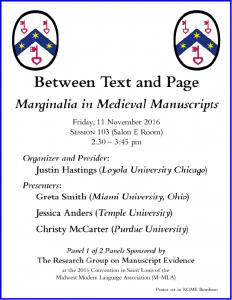
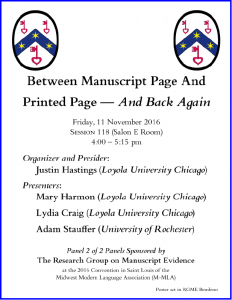 In keeping with our tradition of preparing Posters for Events with our own copyright font Bembino (FREE for download) and according with the principles of our Style Manifesto, we circulated a pair of Posters for the Panels. Our Organizer, Justin Hastings, printed and distributed them both ahead of time and at the Convention.
In keeping with our tradition of preparing Posters for Events with our own copyright font Bembino (FREE for download) and according with the principles of our Style Manifesto, we circulated a pair of Posters for the Panels. Our Organizer, Justin Hastings, printed and distributed them both ahead of time and at the Convention.
Now we publish the Posters here.
I. Between Text and Page: Marginalia in Medieval Manuscripts
Friday, November 11, 2:30 – 3:45 pm
Organizer and Presider: Justin Hastings (Loyola University Chicago)
Presenters:
1. Greta Smith (Miami University, Ohio)
[Title change from the formerly advertised version: “Finding Virtue Among the Scattered Leaves:
The Manuscript Tradition of Otto Ege”]
“Commentary, Marginalia, and Circulation:
The Curricular Aesop”
Abstract: Fable collections circulated widely throughout the Middle Ages. A popular classical form, the fable plays a significant role in medieval language education, storytelling, and social and political commentary. These collections were so popular that there are over 200 extant manuscript of a Latin version of the fables which have been commonly termed the “elegiac Romulus.” While other scholars have noted the widespread popularity of the fables, I seek to address the traces that this popularity left behind in the margins of fable manuscripts.
Fables seem to have played an integral part in medieval language and literacy education, and later became a significant part of medieval literature; all of this usage can be traced through markings left behind by readers in the manuscripts. These markings not only reveal a great deal about how readers interacted with the elegiac Romulus, but their impact can also be traced in the work of later fabulists such as John Lydgate and Robert Henryson.
The extant manuscripts of the elegiac Romulus are similar in many ways. They each contain largely the same fables, in the same order; these similarities indicate one function of fable collections. This continuity also allows for comparison across manuscripts, revealing marginalia that shows how the readers might have interacted with the fable texts. In his work on the fable, Edward Wheatley emphasizes that marginal commentary on the fables had enormous impact on how the fables were studied, as well as on later interpretations.
I seek to take Wheatley’s careful argument for the existence and impact of fable commentary, and use these commentaries alongside the coherence of the fable collection, the ordering of the fables, and other marginalia to look into the variety of readers that were influenced by the fables. I will also discuss the physical characteristics of a number of curricular fable manuscripts, with an emphasis upon clues which offer insight into into reading practices, such as rubrication, locations and frequency of marginalia, binding and wear patterns. Lastly, I will trace exactly how this marginalia impacted fable collections in the later Middle Ages. These clues in the artifacts themselves offer a closer look into the ways that the manuscripts would have circulated, as well as allowing us to better understand which specific fables, and aspects of fables, were significant to readers.
2. Jessica Anders (Temple University, Philadelphia)
“Death in the Margins:
Danse Macabre Imagery in Pierpont Morgan Library, MS M.359”
Abstract: This paper contextualizes the sequence of marginal roundels depicting the Dance of Death in MS M.359. The manuscript, held by the Pierpont Morgan Library in New York, is a French, mid-fifteenth century Book of Hours (digitized online here). The macabre trope of the Dance of Death sprang from a literary tradition, but the text was eventually paired with images, usually in large-scale murals in sacred or cemetery buildings. The Dance of Death consists of a series of people being confronted and led away by personified Deaths, usually in a hierarchical order. Death itself is most often depicted as one or several mobile skeletons in various states of decay.
The presentation of the Dance in MS M.359 (in 58 miniatures over folios 123v–151r) has been divorced from its usual text — which may have some connection to a poem by John Lydgate — and paired with the prayerbook’s Office of the Dead. This paper examines how this particular Dance of Death fits in with marginal, narrative sequences in the rest of the manuscript by inviting the viewer to contemplate the moral and spiritual state of his or her life and its inevitable end.
3. Christy McCarter (Purdue University)
“Compiling Hoccleve’s Series:
The Intellectual Effects of Glossing and Compilation”
Abstract: This paper seeks to identify the hermeneutic potential of marginal glosses within collections including works by the medieval author and book-maker Thomas Hoccleve (c. 1368–1426). Hoccleve’s Series, itself a collection of five shorter texts, is often featured for its autobiographical nature and its moralizing romances. An understudied feature is the inclusion of the short “Learn to die,” a translation of one section of Henry Suso’s Ars Moriendi. Considering how readers compiled The Series after Hoccleve’s death, and how they decorated these books, sheds light on how The Series was received and used by its contemporary audiences.
This project focuses on New Haven, Beinecke MS 493, a fifteenth-century compilation of Hoccleve’s Series with his Regiment of Princes and John Lydgate’s Dance of the Macabre. Explanatory Latin glosses are inconsistent throughout the manuscript; those texts relating to moral living and healthy dying are heavily glossed, while the margins of the romances are almost entirely empty. This pattern apparently corresponds with the purpose of the book and helps to explain why a text such as Lydgate’s would be compiled with The Series. In short, the marginalia works in conjunction with the Dance of the Macabre to shift a focus from Hoccleve’s romances to his speculations on the art of death and dying. Additionally, what is more fascinating in this collection is that Hoccleve’s autobiographical sections (his “Complaint” and “Dialogue”) are also moderately glossed.
The interplay between these different texts – enforced and held together by such marginalia – creates a new text altogether by drawing connections between seemingly unrelated texts. In keeping with the conference and panel themes, I will consider the techniques of compilatio and ordinatio in the collections of Hoccleve’s works in Beinecke MS 493 and Chicago, Newberry Library MS f.33.7.
II. Between Manuscript Page and Printed Page — And Back Again
Friday 11 November, 4:00 – 5:15 pm
Organizer and Presider: Justin Hastings (Loyola University Chicago)
Presenters:
1. Mary Harmon (Loyola University Chicago)
“Missionaries and Darwin:
J.H. Gybbon Spilsbury’s Manuscript on Religious Beliefs of Some Native Tribes in South America”
Abstract: The Newberry Library of Chicago contains some manuscript materials of Rev. Joseph Henry Gybbon Spilsbury, a British nineteenth-century clergyman and linguist. These materials include notes for a Quechua dictionary and grammar book, and a manuscript entitled Religious Beliefs of Some Native Tribes in South America. Dated to 1890, Religious Beliefs provides a brief yet sweeping account of different pre-Columbian beliefs, practices, and myths of several South American groups, including the Incas, Muiscas, and Caras, among others. The document provides an argument that seems to combine two purposes: evangelization and the anthropological study of South American peoples before the Spanish conquest. Spilsbury creates a catalogue of various beliefs, emphasizing that he is trying to do something different from the previous travelers and missionaries who have “moulded and twisted” the beliefs of the people before the arrival of Europeans (Spilsbury 1).
In this paper, I will examine how this document fits into both Victorian scientific discourse and Christian evangelism, as well as how both of those discourses fit into the larger project of British imperialism. Although I recognize that Spilsbury’s document is complicit in imperialism, and at times even perpetuates the very tactics of previous European missionaries he seeks to criticize, I argue that its representation of people in South America breaks from Spilsbury’s intellectual contemporaries in significant ways. While other scholars and naturalists were interested in the evolutionary links between groups of people, they were often fascinated with how different—and therefore backward—indigenous people of South America supposedly were. By thinking about pre-Columbian indigenous beliefs in a familiar monotheistic tradition, Spilsbury creates an account that is more interested in and focused upon the commonalities than differences amongst people.
2. Lydia Craig (Loyola University Chicago)
“The Juvenile and the Erudite:
A Study of the Marginalia in Newberry Case Y 12.T219”
Abstract: This paper proposes to discover and to elucidate the various ways in which Early Modern readers could utilize a printed book to reinforce social standing, to promote fluency and skills in penmanship, and, finally, and to promote good values and educational learning. By examining the marginalia by two hands within Chicago, Newberry Library, Newberry Case Y 12.T219, otherwise known as the Duke of Roxburghe’s copy of All the Workes of John Taylor (London, 1630), I demonstrate how different generations engaged with such a volume as both text and object. While some of the adult’s marginalia in this printed folio indicates political and moral perspectives by expressing approbation through marks, thus subjecting the manuscript to a selective and personal reading process, the child’s marginalia rewrite, imitate, mock, and even change Taylor’s text.
These instances provide physical evidence of how two readers separately constructed their own paratext in order to respond to, or to resist, an author’s “directed meanings,” to use D.F. McKenzie’s term. Furthermore, I deduce the identities of the two writers based on its subsequent ownership by the illustrious John Ker (1740–1804), 3rd Duke of Roxburghe, and propose that books bought by his grandfather Robert Ker (circa 1709 – 20 August 1755) and transported back to the family library in Scotland — such as All the Workes of John Taylor — were intended to educate the next duke, William Ker (1728–1805), about English history and current events in preparation for his eventual role as head of the family. To corroborate the authenticity and exclusivity of the Roxburghe copy’s marginalia to itself, I have compared each image or page of text to that of the copy at Loyola University Chicago, which is in significantly better repair and contains fewer marginalia.
3. Adam Stauffer (University of Rochester)
“Books and Fraternity:
Print Culture and Male Bonding in Gold-Rush California”
Abstract: During the California Gold Rush books and reading proved essential to maintaining social and personal bonds between miners who went west and their loved ones back east. Although some scholars have noted the importance of print in shaping the development of the American West, few have considered how books influenced the composition of letters between friends and family members, as scholars have chosen instead to emphasize the more sensational aspects of Gold Rush life, such as gambling, prostitution, and violence.
In contrast, this paper argues that books and reading enabled miners to create and maintain personal relationships across the continent. Husbands and wives, mothers and sons, and brothers and sisters discussed the latest novels, quoted poems, and even read through letters together. In examining these activities, I shed light not only on the presence of print in Gold Rush California but also on how print was used as a meaning of shaping social and personal interactions across the continent. Additionally, an analysis of these interactions, focusing on the ways in which individuals used print as a means of making meaning through letters, offers scholars a glimpse into the important role performed by print as the United States expanded westward.
*****
Justin Hastings for
The Research Group on Manuscript Evidence
Department of English
Loyola University Chicago
1032 W Sheridan Road
Chicago, Illinois 60626
[email protected]
*****
Here follow Notes on Some Subjects of the Papers
Inspired by the proposals of papers for the panels, we offer some reflections about the subjects, for example in the context of on-going research work by the Research Group on Manuscript Evidence.
*****
I. Memorials of Death in the Margins
The subjects of some papers in these panels strikes a chord with some research reports in our blog on Manuscript Studies.
Examples include:
In the latter case (illustrated here), a user’s entry in the originally blank column follows the end of a series of lections from Patristic authors about astrology. That series belongs to a dismembered 15th-century copy of the Roman Breviary in Latin, of which some other dispersed leaves are known. To judge by its style of script, the added entry at the end of the series probably dates from the late 15th or 16th century. It reproduces a prayer in Latin for a dead individual, excerpted from the Roman Breviary.
Information about this marginal entry and its manuscript context appears in Written In the Stars. Its record of a prayer for a dead individual holds resonance for the subject of several papers in these Panels.
II. The Otto Ege Connection
One of the Papers for the Panels sought at first (as advertised) to address an issue with which the Research Group on Manuscript [and Other] Evidence has had a long-standing engagement: the legacy of manuscripts owned and dispersed by Otto F. Ege. We frequently explore aspects of this legacy and its tangled retrieval, as in our recent Symposium on Words & Deeds (March 2016), its published Program Booklet, its follow-up Report, and some of our blogposts on Manuscript Studies, as shown in its Contents List. The Symposium, Booklet, and blogposts report discoveries regarding various “Otto Ege Manuscripts.” More updates are on the way.
*****
3. Meet the Organizer
We met Justin through his participation in the Research Group’s co-sponsored Session on Medieval Manuscripts in North American Collections at the 48th International Congress on Medieval Studies. The Abstract for his Paper is published here: Hastings (2013 Congress). We thank him for his continuing contributions and his organizational expertise, and offer best wishes for his future work, research, and collaborations.
*****
4. And Now A Word (or Two) From Our Sponsor
For information about the Events of the Research Group on Manuscript Evidence, to which these Sponsored Panels belong, please see our Events and Events Archive.
We distinguish between our Events elsewhere (in various centers in North America and beyond) and our many Congress Activities over the years at the Annual International Congress on Medieval Studies, held at Western Michigan University each May in Kalamazoo. For those activities, we have a Congress Archive, beginning with our Sessions at the 1993 Congress and Photographic Exhibitions — with a special report on The “Prequel” at earlier Congresses.
The pair of panels intended for the 2016 M-MLA Convention represent the first time, apart from the Kalamazoo Congress, that the Research Group sponsors meetings within an existing conference held in North America. We give thanks to our organizer, contributors, and the Midwest Modern Languages Association.
We look forward to your contributions to this new stage in the history of the Research Group. Would you like to join?
Please Contact Us and visit our FaceBook Page for further conversations.
*****
Update: 2017 M-MLA Convention Plans
Gladly we report that, with the initiative and inspiration of Justin Hastings, and with the approval of the Midwest Modern Languages Association committee, plans advance for the Permanent Panels to be sponsored by the Research Group on Manuscript Evidence at the 2017 Convention. Please see the Call for Papers, 2017 M-MLA Panel, and now the 2017 M-MLA Panel Report.
Plans already progress for the 2018 Convention. See you there!
*****

